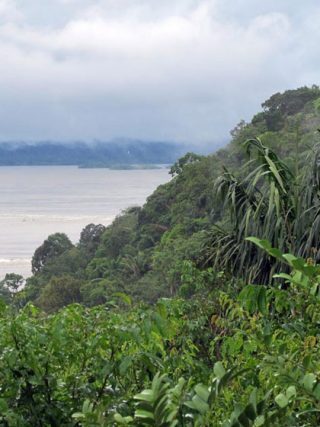Mitigating Global Warming: A Botanical Approach, Part 2
Posted in Environment on February 1, 2019 by Brian Boom
Brian M. Boom, Ph.D., is Vice President for Conservation Strategy at The New York Botanical Garden.

My recent post on Science Talk focused on the importance of planning and executing a coordinated, worldwide scaling-up of ecosystem restoration efforts in order to maximize the potential role of plants in mitigating global warming. At least as important as ecosystem restoration is the need to safeguard the quantity and quality of existing intact ecosystems. Indeed, in a recent report, larger trees were shown to be more efficient at capturing carbon than smaller trees, so mature trees in healthy ecosystems are essential to the efficacy of a botanical approach to mitigating global warming. Another recent report, suggesting that as the climate warms, plants will absorb less carbon dioxide, reinforces the urgency of restoring ecosystems and protecting natural areas.
NYBG scientists are helping to safeguard protected natural areas by documenting their plant diversity and sharing that information with land managers and policymakers. For example, Associate Curator Benjamin Torke, Ph.D., is leading one such research project in Brazil’s Tapajós National Forest and nearby Amazonia National Park, discussed in a previous post on Science Talk and profiled in greater depth here. NYBG has “boots on the ground” in six Areas of Botanical Concern (ABCs), which are regions where conservation action is urgent and NYBG is well positioned to have a major influence on conservation outcomes: North America, the Caribbean, Southeast Asia, Pacific islands, the Atlantic Coastal Forest of Brazil, and Amazonia.
 The Protected Planet Report 2018 confirms that almost 15 percent of Earth’s land surface and inland water and slightly more than seven percent of the global ocean are now protected. It is absolutely essential for the well-being of the planet that these areas are maintained intact, not only for their role in capturing carbon but also because they provide vital refuges for Earth’s diverse plants, animals, fungi and microbes. Actually, the world needs many more protected areas, as advocated eloquently in a New York Times essay, The 8 Million Species We Don’t Know, by NYBG’s Distinguished Counsellor to the Board, Edward O. Wilson, Ph.D.
The Protected Planet Report 2018 confirms that almost 15 percent of Earth’s land surface and inland water and slightly more than seven percent of the global ocean are now protected. It is absolutely essential for the well-being of the planet that these areas are maintained intact, not only for their role in capturing carbon but also because they provide vital refuges for Earth’s diverse plants, animals, fungi and microbes. Actually, the world needs many more protected areas, as advocated eloquently in a New York Times essay, The 8 Million Species We Don’t Know, by NYBG’s Distinguished Counsellor to the Board, Edward O. Wilson, Ph.D.
Saving the plants of the world is a key component of #plantlove, NYBG’s 2019 theme announced earlier this week, a yearlong exploration of the essential connections between plants, people, and the environment. We’ll be showing our love with exciting exhibitions, programs, and projects to help you see plants, know plants, save plants. Learn how you can take action and join us in spreading the #plantlove.

